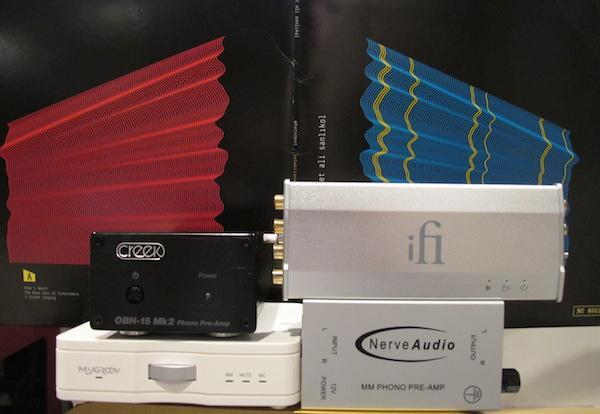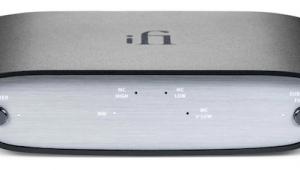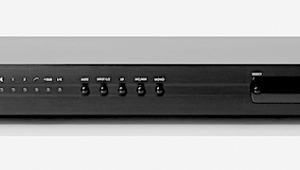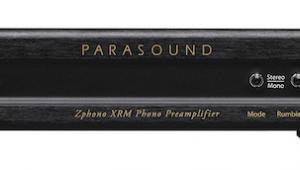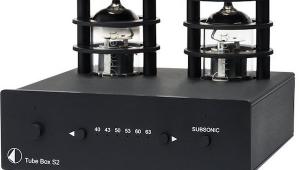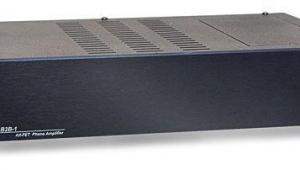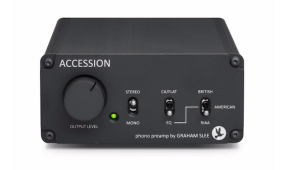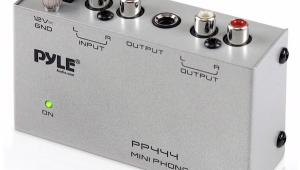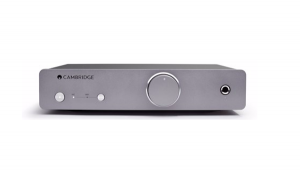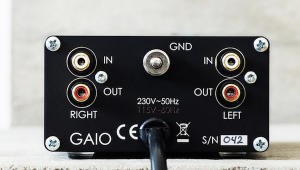How would the iPhono would compare against the Cambridge 640p or 651p, the Musical Surroundings Phonomena II, and the Lehmann Black Cube? Does price really follow quality here? I have heard the 640p and was pleasantly surprised by its performance for its cost, and I currently have a Phonomena II but always wonder if it's a poor choice for the HOMCs that I keep going back to (no loading option between 2k and 50k, which may not be ideal). I do remember hearing the VPI Traveler at Soundstage Direct with the Lehmann and being astounded, though the Manley Stingray II may have been the real magic there. :P
Four Phono Preamps Reviewed
The Nerve Audio PH 1.1
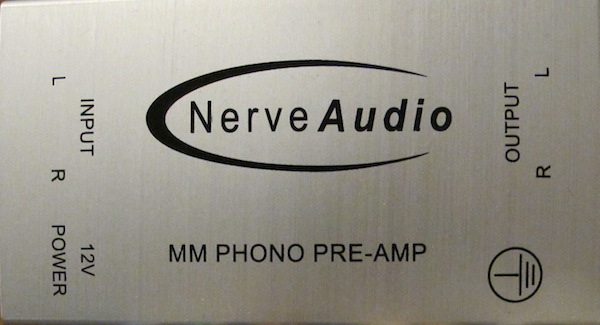
This $99.99 unit originally intended for the custom install home theater market and "budget conscious audiophile" is a small, lightweight, "no-frills" unit 2.5"x1.5"x4.5" powered by a 12v DC "wall wart". The specs claim THD (total harmonic distortion) of less than 0.05% 20Hz-20kHz, 1.5V out with a 5mV input, gain of 40dB and signal to noise ratio of better than 80dB (unweighted).
The PH 1.1 is built "overseas in small quantities" and was designed by Jeff Boccaccio. The only person I could find online with that name is an HDMI specialist so perhaps in a "previous life" he was an analog circuit designer. Whoever designed this thing clearly knew what he was doing.
The only unusual aspect of this "two in, two out" design is that the ground lug is mounted on the output rather than the input side.
The blurb says the Ph 1.1 was designed to compete with phono preamps in the $250 to $350 price range and based on the voting I'd say Nerve has a case.
The Nerve's bottom end was reasonably well controlled (within reason given the price) and well-extended. The overall tonal balance was slightly metallic but really quite acceptable as long as you don't crank up the volume. On the big band test track instruments tended to get pressed together a bit compared to the more expensive units and micro dynamics, not surprisingly were not the PH 1.1's strong suit, but if your modest system needs a bit of edge to wake it up, the Nerve will do it. On the other hand, if your system is brighter than you like, the Nerve's tonal character will only exacerbate the problem.
Overall though, if your budget is around $100 the Nerve will get the job done—which would be to usher you into the analog world without breaking the bank. For $100 I'm not sure what might be better—not that I've heard much lately in that price range.
The Micromega MyGroov

This attractive looking $269 unit, which sort of resembles a Mac Mini can do both MM and MC. Switching between the two is as easy as rotating the front mounted anodized aluminum rotary switch, which goes from “standby” to “MM” to “mute” to MC” and features a built in delay to avoid “thumping”.
There’s no user-adjustability but the designers chose wisely with 47Kohms loading for MM and 100ohms for MC and gain of 40dB and 60dB. MM THD (at 1kHz) is rated at: MM ≤ 0.001% and MC ≤ 0.005%. Signal to noise ratio (A weighted) is MM: 88dB/MC: 76dB). Those are very good specs.
The myGroov features an integrated universal power supply and ultra low noise audio power supply with no capacitors in the audio section, power supply or audio path.
The MyGroov (in MM mode) produced sonics that were pleasingly warm overall, particularly compared to the Nerve Audio’s sound but also somewhat sluggish and lacking in rhythmic “snap”. Bass was richer and more pronounced compared to the Nerve Audio, but the Nerve’s bottom end was “snappier.”
The MyGroov’s midband was rich but somewhat recessed and the top end was less than fully expressed and lacked air and space. Still, depending upon what the rest of your moderately priced system sounds like, the MyGroov might be the perfect compliment to a bright sounding system or an etchy sounding cartridge. Overall though, I thought, the MyGroov’s sound thick and lacking in transient definition and detail. Though if the designer’s goal was to produce warmth he succeeded. (the MyGroov’s MC performance will be covered in a separate review).
The ifi iPhono
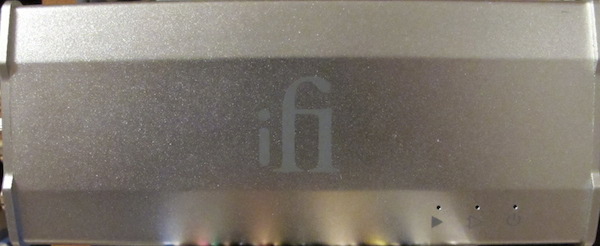
Of the four the iPhono is the only one fully reviewed on analogplanet.com. So please read the full review.
Via 24 tiny dipswitches accessible on the bottom of the 6.5”x 2.5” unit the $399 MM/MC iphono offers unprecedented adjustability in its price class, including 6 EQ curves (RIAA, DECCA, Columbia, “enhanced” RIAA, IEC and eRIAA+IEC), two gain settings for MM (40dB, 46dB) and two for MC (60dB, 66dB), and capacitive and resistive loading.
All of this flexibility would be meaningless if the iphono didn’t sound good but it does. Again, please read the full review but on the one minute track used for the download, the iphono produced a very fine tonal balance that delivered appropriate warmth and “burnish” to the brass without making the snare drum turn to mush. Bass weight was ideal—not too warm and thick and not too light. The iphono’s overall rhythmic “snap” and microdynamic nuance helped make the big band sound more “live” than through any of the other phono preamps in this survey. .
The Creek OBH-15Mk2 Phono Pre-amp

The Mk2 edition of Creek’s renowned OBH-15 is a completely new design featuring an integrated circuit based MM stage and discrete transistor MC stage. While the original’s settings were fixed, the Mk2, via twelve dipswitches located on the chassis bottom, allows for a variety of gain, capacitive and resistive loading options. In MM, capacitive loading can be set to 100 or 200pF, while gain choices are 40 and 50dB.
MC gain choices are 20 and 30dB (on top of the MM setting), while MC loading options are 510 and 100 ohms. Capacitive loading choices in MC mode are 100pF and 1.1nF. Most agree though that the ultra low inductance of moving coil cartridges makes capacitive loading a non-issue.
At $595, the Creek OBH15Mk2 is the most expensive here. Its sound in MM mode was similar to the iphono but the bottom end was somewhat thicker. On the other hand, the Creek’s slightly more pronounced bottom and lower midrange helped produce a greater sense of spatial depth without slowing down rhythm’n’pacing. Switching blind through the four phono preamps here made clear that the Creek’s long-held reputation is being among the best “budget” units is well-deserved.
My Conclusion, My “Vote”
Were I casting a vote for one among the four it would be for the iphono with the Creek coming in a close second, the mygroov 3rd and the Nerve 4th. That’s based on sound.
Given the prices, the Nerve (MM only) impresses for $100, the MyGroov’s middling performance (in MM mode) matches its price, while the iphono at $399, considering both its sonic performance and range of setting options is ridiculously good. The Creek (in MM mode) produced a level of sonic sophistication that made obvious its pedigree, but at $200 less, the iphono, to my ears, offered sonics that while not identical to the Creek’s were more pleasing in terms of rhythmic snap, microdynamics and upper frequency air. Some though might prefer the Creek’s additional warmth without added sluggishness and thickness.
The identities of the four phono preamps in the vote coming up!
- Log in or register to post comments


Hi guys. I would like to share my rave review about Premium Collagen Peptides product from https://valhallavitality.com/ ! This collagen is truly a divine gift for the skin and overall health. I started using it a few weeks ago and have already noticed a noticeable improvement in my skin, hair and nails. This product is truly unique in its composition and quality. It dissolves easily in any beverage, making it convenient and enjoyable to use.
